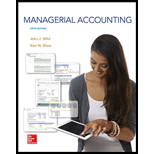
Managerial Accounting
5th Edition
ISBN: 9781259176494
Author: John J Wild, Ken Shaw Accounting Professor
Publisher: MCGRAW-HILL HIGHER EDUCATION
expand_more
expand_more
format_list_bulleted
Question
Chapter B, Problem 15E
To determine
Present Value:
Present value of money means the present or current value of a future
Future Value:
The future value is the value of present cash flow at specified time period and at specified
We have to determine the number of annual investment that will be required in given condition.
Expert Solution & Answer
Want to see the full answer?
Check out a sample textbook solution
Students have asked these similar questions
Kevin Morales invests $7,302.63 now for a series of $1,500 annual returns beginning one year from now. Kevin will earn a return of 10% on the initial investment. How many annual payments of $1,500 will Kevin receive?
Steven Garcia invests $14,404.31 now for a series of $2,700 annual returns beginning one year from now. Steven will earn a return of
10% on the initial investment.
Click here to view the factor table 1.
Table 2
Table 3
Table 4
How many annual payments of $2,700 will Steven receive? (Hint: Use Table 4.) (For calculation purposes, use 5 decimal places as displayed
in the factor table provided, e.g. 5.24571. Round answer to O decimal places, e.g. 25.)
Number of annual payments
eTextbook and Media
Save for Later
Attempts: 0 of 5 used
Submit Answer
Sagar
Knowledge Booster
Similar questions
- Betty Harris wants to accumulate $11,000 by the end of 12 years. If the annual interest rate is 5.9 percent and interest compounds semiannually, how much will she have to invest today to achieve her goal? (Round intermediate calculations to 6 decimal places, e.g. 2.512512 and final answer to 2 decimal places, e.g. 2,515.25.) Present value of investment $arrow_forwardAn investment pays $200 at the end of Year I. $250 at the beginning* of Year 2. $387 at the end of Year 4. and $500 at the beginning of Year 6. If other investments of equal Mk earn 7.5% annually. what will be this investments present value and future value?arrow_forwardCalculate the time necessary to achieve an investment goal. Give your answer to the nearest day. Use a 365-day year. (First enter the total number of full years, then give the remaining days.) $9,000 at 4% daily interest; deposit $6,000arrow_forward
- An individual has $1,000 to invest. He wants to accumulate $3,670 and can earn 8% annual interest on investments, compounded annually. How many years will it take to attain his goal?arrow_forwardWhat is the IRR for a $1500 investment that returns $300 at the end of each of the nexta.7 years?b. 6 years?c. 100 years?d. 2 years?arrow_forwardUsing the TVM calculator, compare the following if the investment pays 7%/a compound annually and payments are made until age 65. Calculate the future value of each investment and the total amount paid in. which would you choose? a) depositing $1500 every year starting at age 20. b) depositing $4500 every year starting at age 50.arrow_forward
- Bill is considering investing $450 at the end of each month in a fixed incone instrument. He will receive $27,000 at the end of four years. If interest is compounded monthly, what is the effective annual rate of return on the investment. A. 22.3% B. 15.1 % C. 11.6 % D. 11.1 % E. 13.6 %arrow_forwardYou are able to invest $100 at the end of 1 year into an investment earning 6%. At the endof year 2, you are going to add $1,000 to this investment and at the end of year 3, you are going to addanother $1,000. What will the investment be worth at the end of year 3?arrow_forwardToday, Thomas deposited $170,000 in a three-year, 4% investment account that compounds quarterly. What is the maturity value of the investment account? Note: Use tables, Excel, or a financial calculator. Round your final answer to the nearest whole dollar. (FV of $1, PV of $1, FVA of $1, and PVA of $1).arrow_forward
- Assume today is January 1 and you plan to invest $4,000 today in an account earning interest of 6% compounded semi-annually. You would like to calculate the amount your investment will grow to three years from now.Question: What should be the correct "n" and "i" to use for factor table purposes in order to answer your question?arrow_forwardCalculate the future value for the following investment’s Initial investment of $6,000, maturity 5 Years, interest paid annually at 4.5% Show your work Initial investment of $6,000, maturity 5 years, interest paid semi-annually at 4.5% Show your workarrow_forwardAn investor is considering an investment that will pay $2,280 at the end of each year for the next 10 years. He expects to earn a return of 12 percent on his investment, compounded annually. Required: a. How much should he pay today for the investment? b. How much should he pay if the investment returns are received at the beginning of each year? (For all requirements, do not round intermediate calculations and round your final answers to the nearest whole dollar amount.) a. Present value of ordinary annuity b. Present value of annuity duearrow_forward
arrow_back_ios
SEE MORE QUESTIONS
arrow_forward_ios
Recommended textbooks for you
